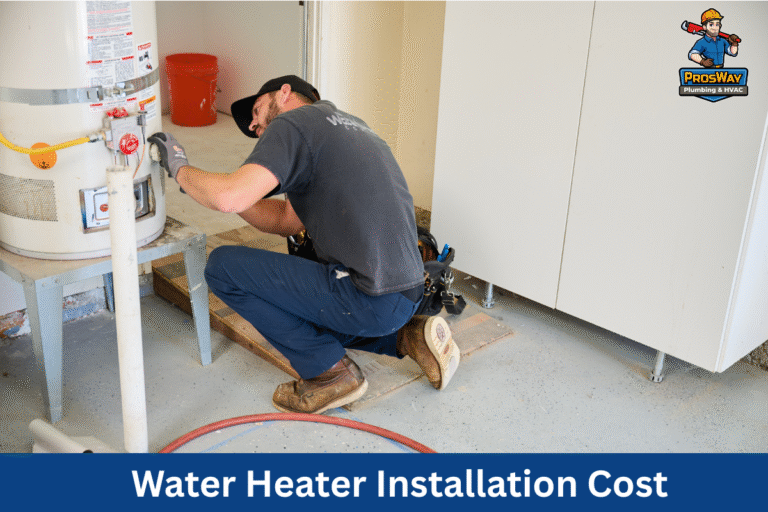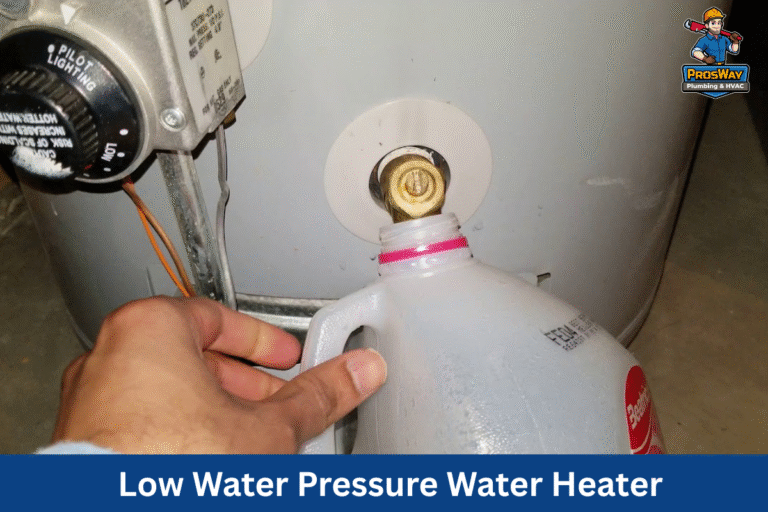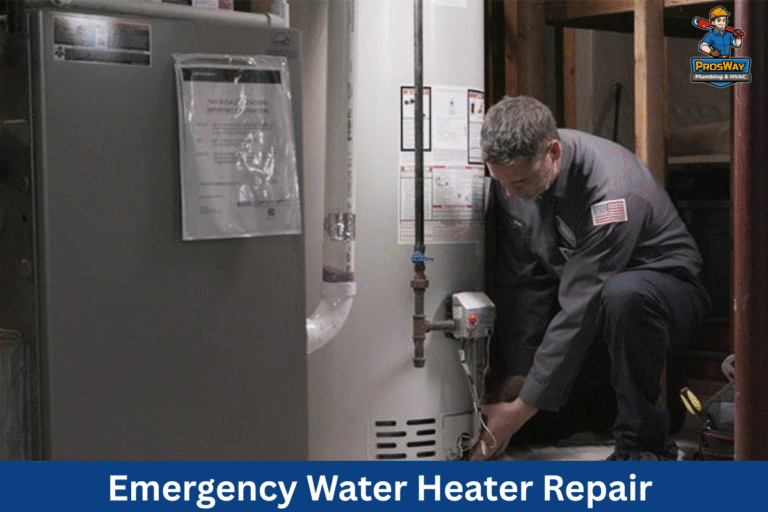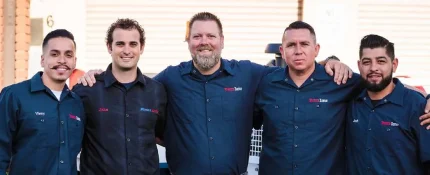Wondering if your home’s plumbing issues might point to something more serious? Strange smells, slow drains, or soggy spots in your yard could all be warning signs of a damaged sewer line. Early detection is the key to avoiding costly repairs. This guide walks you through the top signs indicating your sewer line needs immediate repair, so you can take action fast, protect your home, and keep your plumbing flowing smoothly.
Indoor Warning Signs
Here are some of the most frequent indoor signs indicating your sewer line needs immediate repair:
1. Persistent Sewer Odors
Homeowners should be aware of unusual sewer smells that may indicate a sewer line clog or leak. These odors often arise from the breakdown of waste in blocked pipes, which can lead to backups in the plumbing system.
It may indicate deeper issues that require professional assessment if foul odors persist, such as unaddressed sewer line problems.
In addition to rotten egg smells, homeowners might notice an earthy or musty odor due to erosion around the sewer line. This erosion can compromise the integrity of the pipes, leading to leaks and further deterioration.
Therefore, swift action is essential to address these odors, as they often highlight a pressing need for repair.
How Can You Differentiate Between Sewer and Other Household Odors?
You can distinguish between sewage odors and other unpleasant smells by paying attention to the scent’s characteristics.
A strong, sulfur-like smell often indicates sewer gas, which can result from a damaged sewer line.
In contrast, musty odors in the bathroom could point to mold or mildew rather than a sewage issue.
Knowing these differences allows homeowners to address problems effectively, such as scheduling leak detection.
Another important factor is the location of the smell. This may signal a sewer line issue if foul odors are more pronounced near plumbing fixtures or drainage areas.
2. Gurgling / Bubbling Fixtures
Gurgling sounds from plumbing often indicate issues with the main sewer pipe.
These noises can suggest blockages that may lead to more severe hazards, including mold growth from sewage. Prompt attention to these signs can prevent the need for sewer line replacement.
Impact of Gurgling on Home Plumbing
Gurgling sounds in plumbing often signal issues that can affect the overall drainage system of a home. These noises may arise from clogged sewer lines where water struggles to pass through, causing backups.
The consistent gurgling near sinks could indicate a broken sewer pipe. Ignoring gurgling sounds can lead to bigger problems, including malfunctioning heat pumps and an increased risk of sewage backups.
Sources of Gurgling Noises
One frequent culprit is the buildup of debris, such as hair and soap residue, which can lead to blockages in the pipes.
When the flow of water is obstructed, air can get trapped, causing those characteristic gurgling sounds created by clogs.
Another significant source of gurgling is corrosion within the sewer line, which can compromise the integrity of the pipes over time.
So, address these gurgling noises promptly to prevent potential water damage and further degradation.
3. Multiple Slow Drains
Slow drainage is a common issue that can signal potential plumbing problems. Homeowners must pay close attention when multiple drains start to slow down simultaneously. This issue often points to a potential sewer line problem, such as a broken sewer line.
It may indicate a deeper blockage in the sewer system if several fixtures, like sinks and toilets, are affected simultaneously. It could indicate a broken sewer line in the plumbing system if water pools or drains unusually slowly.
Another critical factor to consider is noise during drainage. Ignoring simultaneous slow drains can lead to larger complications, including severe clogs and unexpected sewage backups.
4. Recurring Clogs Across Fixtures
Frequent clogs in the plumbing system can signify serious issues, particularly with the main sewer line.
Therefore, be alert to the potential for more than just temporary blockages. These clogs can lead to persistent odors and other signs of trouble.
It may indicate significant pipe damage that requires immediate assessment if a drain frequently backs up.
Addressing frequent clogs promptly is vital to prevent further complications such as sewage backup that can damage a home’s foundation or create health hazards.
Consulting a plumbing expert can provide insights, allowing for a properly functioning drain system.
5. Toilet Water Level Swings
Assessing the toilet’s functionality is vital for homeowners when determining potential sewer line issues. Fluctuations in toilet water levels can be telltale signs of sewer line problems. Rising and falling water levels may indicate blockages or leaks that disrupt the flow of waste through the plumbing system.
It may signal a need for immediate professional evaluation if the water rises unexpectedly and refills properly. A properly functioning toilet should maintain consistent water levels during and after flushing.
When homeowners notice irregularities, such as gurgling sounds or unusual water behavior, it is crucial to take these signs seriously.
What Are Common Causes of Toilet Water Level Fluctuations?
Common causes of fluctuations in toilet water levels often include blockages within the plumbing system. These blockages can occur due to a buildup of waste, toilet paper, or foreign objects that restrict the flow of water.
So, monitor these changes, as they may signal a need for immediate attention. Another significant factor contributing to irregular toilet water levels is damage to the sewer line itself.
Cracks, breaks, or deterioration can disrupt the normal flow, causing erratic behavior in the toilet’s water level.
6. Sewage Backing Up Into Tubs or Showers
Sewage backing up into tubs or showers is a strong indication of a blockage or damage within your sewer line system.
When waste cannot properly exit through the pipes, it finds the nearest escape route, often your lowest plumbing fixtures.
This issue can lead to unpleasant odors, exposure to harmful bacteria, and potential property damage.
Therefore, contact a professional as soon as you notice this symptom. A licensed plumber from ProsWay Plumbing & HVAC can assess your system and restore proper function before the problem escalates.
Addressing backups swiftly is one of the most effective ways to identify sewer line problems early and avoid costly repairs.
7. Moisture, Mold, or Stains Linked to Drain Gas Leaks
Mold growth in a home is often a sign of excess moisture, which can stem from various issues. Closely inspect areas where mold appears, such as bathrooms, basements, and kitchens, as these spots are prone to high humidity.
Mold can pose health risks, making it essential to address the root cause promptly. Homeowners must investigate the source of the moisture if mold is discovered.
In many cases, this could indicate a sewer line leak that allows wastewater to saturate walls and floors.
Moreover, water stains appearing on walls or ceilings can be a strong indicator of sewer line problems needing immediate attention.
These stains often result from leaks in the plumbing system, which may allow wastewater to infiltrate walls and ceilings.
So, be especially vigilant for discoloration, as it can signal active leaks that, if left unchecked, can cause damage. In many cases, water stains can also foster mold growth, creating health risks for residents.
Outdoor / Structural Warning Signs
1. Wet or Sunken Yard Areas
Identifying soggy areas in the yard is crucial for discerning sewer line problems. Always be vigilant for unexplained puddles in your yards, especially those that persist long after rain has stopped.
Such water accumulation can indicate a sewer line leak, which is susceptible to cracking over time.
Ignoring these signs may create favorable conditions for bacterial growth, posing health risks to the household.
Moreover, water pooling near the foundation can compromise the integrity of the basement if left unaddressed.
How Does Landscaping Reveal Sewer Line Issues?
Homeowners dealing with sewer line issues often notice how water accumulation impacts their landscaping.
When sewer leaks occur, they can create wet areas that disrupt the health of plants and grass. The excess moisture can lead to root rot in trees and shrubs, compromising their stability and growth.
Recognizing these signs early can help prevent irreversible damage to the garden and yard space. The presence of standing water can promote mold growth, which poses health risks to residents.
Spot Areas of Exceptionally Green Grass Growth
Spotting areas of exceptionally green grass growth can serve as a key indicator of potential sewer line issues.
When a sewer line leaks, nutrients and water can seep into the surrounding soil, fostering lush patches of grass that stand out against the rest of the lawn. So, pay attention to these unusual growth patterns.
They may signal underlying plumbing problems that need immediate inspection.
2. Sudden Pest or Rodent Activity
Unwanted pests, such as rodents and insects, can be clear indicators of sewer line problems. When sewer lines leak, they create moisture and attract pests like rats and cockroaches, which thrive in damp environments.
Homeowners noticing an increase in these pests can view this as a warning sign that their sewer system may require repair.
Additionally, the presence of fruit flies and drain flies can signify problems with the sewer line.
These pests often breed in organic waste within clogged pipes or sewer lines. So, act quickly when you observe these signs and address the underlying sewer issues.
What Preventive Measures Can You Take Against Pest Intrusions?
To prevent pest problems linked to sewer line issues, first focus on maintaining proper sanitation practices. Regular drain cleaning and ensuring that no food particles accumulate can help deter pests like drain flies and roaches.
Additionally, sealing any cracks or gaps in walls and around pipes will reduce entry points for unwanted pests.
Another effective measure is to schedule routine inspections of the sewer line and overall plumbing system.
3. Tree Root Indicators
Tree root infiltration is a common cause of sewer line problems. As roots seek moisture, they can easily penetrate small cracks or joints in aging pipes.
As the roots grow, they can obstruct the flow of wastewater, leading to severe clogs and potential backups.
So, be aware of any unusual drainage issues, such as slow sinks or frequent toilet backups, which may signal root intrusion in the sewer line.
To recognize root damage early, homeowners can look for signs such as lush patches of grass above the sewer line, which could indicate a leak from the pipes.
Risk Factors that Raise Odds

1. Aging Pipe Infrastructure and Materials
Aging pipe infrastructure is a significant factor contributing to sewer line issues. Over time, materials such as cast iron, clay, and even PVC can deteriorate due to corrosion, wear, and environmental factors.
Homeowners must be vigilant about their plumbing system’s age. Older pipes are more susceptible to cracks and leaks, leading to costly repairs and disruption in the home.
Especially if their property has plumbing that is several decades old, proactive measures can ensure early identification of potential sewer line issues.
2. How Do Ground Shifts or Nearby Construction Contribute?
Ground shifts caused by natural factors or heavy construction can lead to significant sewer pipe failures. These movements may cause pipes to crack or become misaligned, disrupting the flow of waste.
Therefore, stay alert to any changes in your property’s landscape, especially if construction activities occur nearby, as this can increase the risk of sewer line issues.
To mitigate damage from ground shifts or heavy construction, homeowners can schedule regular plumbing inspections.
Identifying early signs of sewer line problems, such as slow drainage or unusual odors, can prevent more severe issues later.
3. Improper Slope or Installation Errors
Gravity is everything in a sewer line. Wastewater outruns solids, causing a buildup if the slope is too steep. Too flat? Flow slows, leading to clogs.
Improper slope usually stems from poor construction practices, especially in home additions or remodels where new pipes tie into the original system. A camera scope can show whether waste is pooling in low spots or backing up due to a flat or reverse slope, a common issue in DIY or rushed installations
How to Confirm the Problem?
The first step is figuring out what’s actually wrong and where, if you’re dealing with slow drains, gurgling toilets, or potential sewer backup. You don’t want to start digging or replacing pipes based on guesswork.
Studies published by the Journal of Environmental Health (2019) indicate that timely detection of issues can reduce repair time by up to 40%.
In northern New Jersey, residents should consider both indoor symptoms (such as gurgling sounds behind walls and unexpected backups) and outdoor signs (like muddy patches in the soil or lush, green areas from extra nutrients) are red flags.
These are all strong signs indicating you need sewer line repair services, and addressing them early can prevent further damage.
Here’s a step-by-step rundown of how homeowners and pros confirm problems in the wastewater system, from basic DIY checks to advanced diagnostic tools.
Plunge First
Start simple. Use a plunger if one toilet or sink is slow. This can dislodge minor clogs in the drain line, especially in bathrooms or kitchens. The issue was likely isolated if it clears quickly.
Try a Drain Snake
For tougher clogs, a handheld or powered drain auger (snake) can go deeper into the pipe. This works well for local blockages caused by hair, grease, or debris, but won’t help with collapsed or misaligned underground piping.
Check the Cleanout
Your cleanout is the access point to your main sewer line. If you open it and water spills out, that’s a clear sign of a main line blockage. The issue might be in a branch line or inside the house, if it’s dry.
Dye Tests
Dye testing involves flushing colored dye through sinks or toilets to check for leaks or improper connections. It’s especially useful for identifying cross-contamination between sewer and stormwater systems, and for detecting hidden leaks.
Sewer Camera Scope
Advanced diagnosis also involves using sewer cameras to inspect the pipeline integrity and locate blockages or tree root intrusions, essential for effective sewer line repair. Notably, a sewer camera inspection can visualize the inner lining of pipes, detect cracks, corrosion, or significant damage, and help prioritize sewer-line-repair methods.
Smoke Test (for Sewer Gas Odors)
A smoke test might be used if you’re dealing with sewer gas smells inside the home. This involves pumping safe, artificial smoke into the pipes to see where it escapes, perfect for finding venting issues, cracked pipes, or unsealed drains.
Other Methods
Homeowners may also inspect plumbing vents and sump pumps for irregularities, as leaks can affect multiple components.
It is advisable to consult with a professional technician, who often uses acoustic leak detection devices for sewer line repair. These devices can precisely pinpoint leakage locations, increasing repair efficiency and reducing costs.
ProsWay Plumbing & HVAC uses state-of-the-art diagnostic tools to verify sewer line conditions and advise homeowners on the necessary repair or replacement steps.
Common sewer line problem indicators and diagnostic tools:
| Symptom | Location | Likely Cause | Recommended Tool |
| Slow drains, frequent clogs | Indoors | Blockage or buildup | Drain snake, camera inspection |
| Foul sewage odors | Indoors/Outdoors | Leaks, venting issues | Smoke test, camera inspection |
| Wet or muddy patches in the yard | Outdoors | Pipe break or root intrusion | Acoustic leak detection |
| Gurgling sounds from pipes | Indoors | Air pressure issues or block | Sewer scope/camera |
| Unusually green grass patches | Outdoors | Nutrient leakage from the pipe | Soil probe, camera inspection |
DIY vs Pro: What You Can Safely Try?

In most cases, fixing sewer line issues is not recommended as a DIY project due to the complexity and potential safety hazards.
What You Can Safely Try:
- Clearing Traps: Check the P-trap under the sink if a bathroom or kitchen sink is slow. Remove and clean it to clear soap scum, food, or hair buildup.
- Minor Snaking: A handheld snake can clear out clogs in branch drain lines, like sinks or tubs. Don’t force it if you hit resistance; that could be a sign of a more serious blockage in the main sewer line.
- Enzyme-Based Drain Cleaners: Monthly use of enzyme products (not harsh chemicals) can help keep your pipes clear of organic buildup. These are ideal for preventative maintenance, especially in homes prone to slow drains.
According to a study by the International Association of Plumbing & Mechanical Officials (IAPMO, 2021), improper repair attempts can cost homeowners 25% more in subsequent repairs.
Attempting a DIY fix may seem cost-effective, but without proper tools such as sewer cameras or acoustic devices used in sewer line repairs.
In addition, exposure to sewer gases and contaminants poses health risks. The design intricacies of modern sewer lines, including those prone to root invasion or corrosion.
What to Leave to the Pros:
Symptoms Persist After Standard Drain Cleaning
It is a clear indication that there may be deeper issues within the sewer line if symptoms persist after standard drain cleaning.
Homeowners must not overlook repeated clogs or slow drainage. These can signify serious blockages or damage beyond simple maintenance.
Engaging a professional for a thorough sewer inspection will provide an accurate assessment.
Continuing drainage issues despite routine cleaning could point to situations such as tree root infiltration.
Homeowners need to prioritize these signs and seek expert evaluation to prevent further complications.
Why Do Multiple Warning Signs Occur Simultaneously?
When multiple warning indicators appear at once, it is a strong sign that homeowners should seek a professional sewer line inspection.
Symptoms such as frequent backups, slow drains across different fixtures, and unpleasant odors can signify underlying issues.
Ignoring these combined warnings can lead to more significant plumbing problems and expensive repairs in the future.
A proactive approach is essential in these situations. Homeowners experiencing several warning signs together should not hesitate to contact a qualified plumbing expert.
Taking swift action can help address potential sewer line problems early. Ensuring the plumbing system remains functional and efficient in their homes.
Professional sewer line repair ensures precise leak detection and repair techniques that prevent future problems. Professionals use trenchless technology when possible to minimize excavation and duration.
When to Call for Inspection (Timing Guide)
Sewer line inspections should be conducted at least every two to three years or immediately after heavy storms, tree work, or major construction nearby.
Regular assessments help catch early signs indicating you need sewer line repair services, such as wear and clogged drains, before they worsen into costly repairs.
Homeowners in northern New Jersey should schedule inspection appointments proactively. Using reliable tools can detect the beginnings of corrosion. This frequency of inspection is particularly important in areas with significant tree coverage or where soil conditions promote pipe degradation.
We recommend consulting with a trusted provider such as ProsWay Plumbing & HVAC to develop a tailored inspection plan for your home.
Their expertise in sewer line repair ensures that any potential issues are addressed promptly, saving you from future emergency repairs.
Service Options From ProsWay Plumbing
ProsWay Plumbing & HVAC offers a full range of sewer services, including leak detection, sewer line repair, trenchless sewer line repairs, and complete sewer line replacements.
Our technicians use advanced equipment to diagnose and resolve sewer issues effectively. Recent customer surveys indicate that their prompt service reduces recurring issues by over 40%.
Their offerings cover emergency leak repairs, sewer line repair, drain cleaning, maintenance check-ups, and preventative inspections.
This holistic approach minimizes the chance of unexpected breaches and backups. In practice, these services have resulted in better overall system longevity.
Coupled with HVAC expertise, ProsWay Plumbing & HVAC ensures that every aspect of your building’s infrastructure and in compliance with modern standards.
By selecting a trusted partner like ProsWay Plumbing & HVAC, you secure peace of mind knowing that their sewer line and plumbing systems are in expert hands.
Long-Term Prevention & Maintenance Schedule

Implementing Routine Maintenance Practices
Implementing routine maintenance practices is vital for preventing sewer issues. Keep an eye on the plumbing system by regularly checking for slow drains, unusual sounds, or bad odors.
Simple tasks, such as drain cleaning and avoiding the disposal of grease, can significantly decrease the chances of blockages.
Scheduling annual plumbing inspections with a professional can further enhance the long-term health of a sewer system.
During these inspections, technicians can identify early signs of common sewer issues, providing insights into necessary repairs.
What Are the Benefits of Sewer Line Upgrades?
Upgrading sewer lines can significantly enhance a home’s plumbing system, reducing the risk of frequent blockages and backups.
Newer pipe materials are often more durable and resistant to tree root infiltration and corrosion, leading to fewer repairs over time.
Homeowners who invest in these upgrades ensure long-term safety and reliability for their households. Additionally, modern sewer line upgrades can increase a property’s value and appeal.
Potential buyers often prioritize homes with updated plumbing systems due to the reduced likelihood of hidden issues.
FAQs
1. How do I know if my sewer line is damaged?
Watch for frequent backups, foul odors, soggy patches in the yard, or slow drains across multiple fixtures; these often signal a break or collapse.
2. How can I tell if my sewer line is clogged?
Multiple slow drains, gurgling toilets, or water backing up in lower fixtures usually point to a main sewer line clog.
3. How to detect a sewer line?
Professionals use electronic pipe locators during a sewer camera inspection to trace the pipe’s path and depth underground.
4. Can tree roots really damage a sewer line?
Yes. Tree roots naturally seek moisture and can break into small pipe cracks or joints, leading to major blockages, backups, or even complete line collapse.
5. Is a foul smell in the yard a sign of sewer trouble?
Absolutely. A persistent sewage odor outdoors, especially near your drain field or cleanout, often indicates a crack or leak in your underground sewer line.
Summary
- Unpleasant Odors: Persistent foul smells near drains may indicate sewer line clogs or leaks; often sulfur-like or musty from erosion.
- Gurgling Sounds: Bubbling or gurgling noises from sinks and toilets suggest trapped air from clogs or pipe damage.
- Multiple Slow Drains: Simultaneous slow drainage in several fixtures signals a possible deep blockage or broken sewer line.
- Frequent Clogs: Recurring backups can indicate major issues with the main sewer line, not just isolated drain problems.
- Water Accumulation in Yard: Standing water or soggy patches in lawns can result from leaking or cracked underground sewer pipes.
- Lush Grass Growth: Abnormally green patches over sewer lines can point to nutrient-rich leaks beneath the soil.
- Pest Infestations: Rats, cockroaches, and drain flies are drawn to sewer leaks and organic waste buildup.
- Fluctuating Toilet Water Levels: Rising and falling water in toilets without flushing may suggest sewer blockages or leaks.
- Sewage Backups in Showers/Tubs: Wastewater flowing into low-lying fixtures is a clear sign of sewer line obstruction.
- Mold and Water Stains: Excess moisture from sewer leaks can trigger mold growth and leave visible stains on ceilings and walls.
- Aging Pipes: Old sewer lines made of clay, cast iron, or early PVC degrade over time, leading to cracks and collapses.
- Tree Root Infiltration: Roots seek moisture from sewer lines, infiltrating cracks and blocking waste flow.
- ProsWay Plumbing Services: Offers leak detection, trenchless repairs, replacements, and routine maintenance using advanced equipment.
- Routine Maintenance: Includes annual inspections, drain cleaning, and preventing grease/solid waste disposal in drains.
- Sewer Line Upgrades: Modern materials resist roots and corrosion, reduce future issues, and improve home resale value.
Don’t let minor signs escalate into major problems. It’s time to take action if you’re experiencing toilet water level fluctuations. Call us now at (862) 260-5870 or Book Online today to schedule a comprehensive inspection and ensure your plumbing system operates flawlessly.









